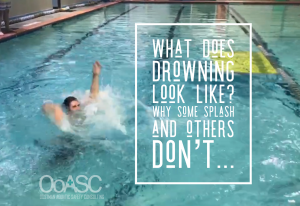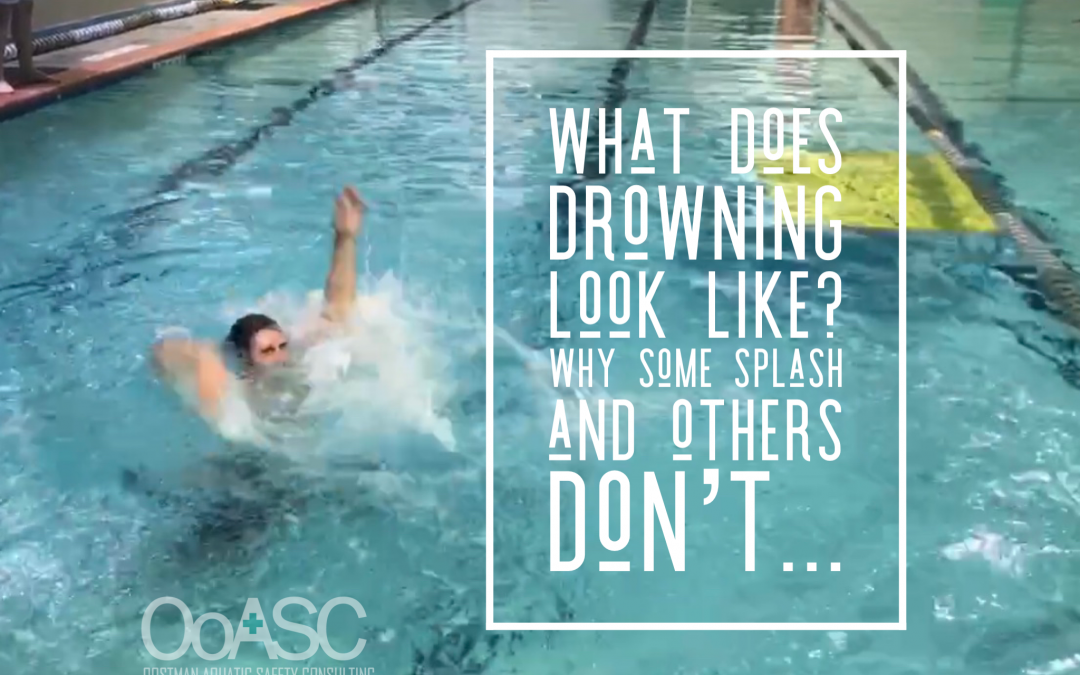 First, let’s start with the fact that the title of this article is the truth: some people DO splash and others DON’T when they are drowning. We have been able to review hundreds of videos of people in the drowning process and I want to start by making sure we are on the same page. Sometimes we see large amounts of copious splashing, sometimes a little splashing, sometimes intermittent splashing, and sometimes no splashing at all. As a baseline, we need to make sure our lifeguards (and parents) are prepared for the realities of what a person looks like in distress. Before we get into the reasons of why I think some people splash and others don’t, I want to make sure as instructors of lifeguards we think about this fact and train to this fact. Think about how you teach distress, how your lifeguard students display distress and act the part of a patient, and how you talk about surveillance. Be real, prepare them for reality. We all talk about that idea that drowning doesn’t look like in the movies, but what does it really look like? Give details and prepare them well.
First, let’s start with the fact that the title of this article is the truth: some people DO splash and others DON’T when they are drowning. We have been able to review hundreds of videos of people in the drowning process and I want to start by making sure we are on the same page. Sometimes we see large amounts of copious splashing, sometimes a little splashing, sometimes intermittent splashing, and sometimes no splashing at all. As a baseline, we need to make sure our lifeguards (and parents) are prepared for the realities of what a person looks like in distress. Before we get into the reasons of why I think some people splash and others don’t, I want to make sure as instructors of lifeguards we think about this fact and train to this fact. Think about how you teach distress, how your lifeguard students display distress and act the part of a patient, and how you talk about surveillance. Be real, prepare them for reality. We all talk about that idea that drowning doesn’t look like in the movies, but what does it really look like? Give details and prepare them well.
After viewing hundreds of rescues and drowning events in the course of our work, I’ve broken it down into 5 areas that impact whether the drowning process started with splashing or not. Here are my take aways:
1 – How they entered the water: How someone enters the water can play a role in splashing because it impacts their level in the water and access to the surface. Often we will see children who jumped into the deep end display no splashing because their entry into the water caused their struggle to begin with water already over their head. A similar age child, who is moving from shallow to deeper water as they begin distress may create splashing as they are closer to the surface of the water.
2 – Skill Level / Strength / Size related to depth of Water: All of these factors play a role in how a person is able to stay at or near the surface of the water, and as a result if we will see splashing. I believe a persons swimming abilities and strength can play a role in the production of splashing or not. We will also see intermittent splashing if their size and depth of water allows them to push off the bottom and return to the waterline. If they have the skill level to keep their body near the surface, the strength to power themselves near the surface, or even the size to bob off the bottom, we may see splashing, and we may see a lot of it the higher they are able to keep their body out of the water or at the surface line. I see adults able to produce more splashing than children sometimes because of their size and strength.
3 – Instinct: Drowning is an instinctual response. We don’t sit people down in a classroom and train them on how to go into distress, or how to panic or act surprised. People respond how they respond. There are a million different ways that people physically respond when something panicky happens. Think about people who are scared and crumble quietly into a ball, or people who scream as loudly as possible, or people who run away, or people who freeze in position. Our response is our response and it may be completely different than another person’s in the same situation. I’ve had lifeguards explain that a child was under the water and looking up at them, but there wasn’t any splashing, so they thought they were okay and just playing. Sometimes people just freeze. We see a high number of children do somersaults or spin in the water, which to a lot of people would mimic playing. I personally remember rescuing a boy from the deep end of the wavepool who was standing on the bottom looking up at me in the most peaceful manner like a statue. Nothing I had ever expected.
4 – Type of Event – We classify aquatic related events we investigate into two types of events: skill-related events and medical-related events. Medical-related events are increasingly common and are often quiet events with no struggle or splashing at the surface. We don’t see people with a cardiac event, seizure, brain aneurism or other type of medical concern in what we could typically think of commonly as “distress” with splashing.
How we see people present in the drowning process:
- Splashing (sometimes a lot, sometimes a little or intermittent, sometimes none at all)
- Arms (sometimes out by side, sometimes climbing motion, sometimes in circles by sides, sometimes no motion at all)
- Legs (sometimes moving, sometimes not moving at all, sometimes a kick without much motion)
- Airway (underwater, both underwater and above water intermittently)
- Body Positioning (vertical, horizontal, face up, face down, suspended in water, at the surface, at the bottom)
- Body Movements (little forward progress, static and not moving, moving & jerking, summersaults during distress, moving with water movements and currents)
- Head Positioning (sometimes back, looking up, sometimes down)
- Reactions (may reach for something or someone close, may yell for help as they start to panic, may have no visible reaction)
I hope you are getting the point that we need to be careful how we explain, demonstrate, and describe distress to people. There is no single presentation I can tell you that everyone will take every time a drowning event begins. The drowning event is a process and their response and positioning will continue to change as they work through the process and as their personal factors (increased tiredness, decreased oxygen) and environmental factors change (depth of water, things/people in the water). Their ability to demonstrate splashing will be determined based on a number of factors, and may or may not be present.
This is the challenge with lifeguarding. The drowning process is such an individual and personal response and many of the behaviors exhibited overlap with swimming behaviors which can be confusing. My hope in sharing this is to start the process of educating and to bridge the gap between training and reality.
Natalie Livingston

